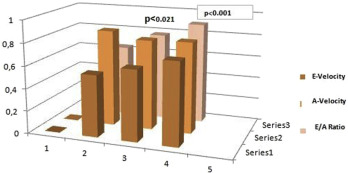Aims
Transcatheter valve implantation (TAVI) techniques have emerged as an alternative treatment for patient with severe aortic stenosis and high surgical risk. Myocardial hypertrophy as a consequence of cellular hypertrophy and cellular matrix hyperplasia occurs before the development of diastolic dysfunction in patients with severe aortic stenosis. After transcatheter valve implantation diastolic stiffness improvement is expected in the follow-up. This study was aimed to determine the effects of transcatheter aortic valve implantation on diastolic function before and after medium-term follow-up.
Methods and Results
One hundred thirteen patients with severe aortic valve stenosis submitted to successful TAVI were included. All procedures were guided through transosephageal echocardiography and parameters of diastolic function were evaluated before and after six and twelve months after TAVI. The mean age was 79.7±5 years and mean log EuroSCORE was 29.3±9.8.STS was 11.7±3.2. Aortic valve area was 0.66±0.12 cm 2 . Mean and post TAVI gradient were changed significantly (46.4 mmHg vs 10.4 mmHg, respectively, p<0.05). Before the TAVI procedure, all patients presented with LV diastolic dysfunction. E-wave velocity was not changed significantly before and after 6 and 12 months of TAVI (p>0.05). A-wave velocity was not changed significantly before and after the procedure (p> 0.05). Only the E/A ratio was changed significantly after 6 and 12 months following TAVI procedure (p<0.05).
Conclusion
Our results present improvement in diastolic function at medium term follow-up after the TAVI procedure.





